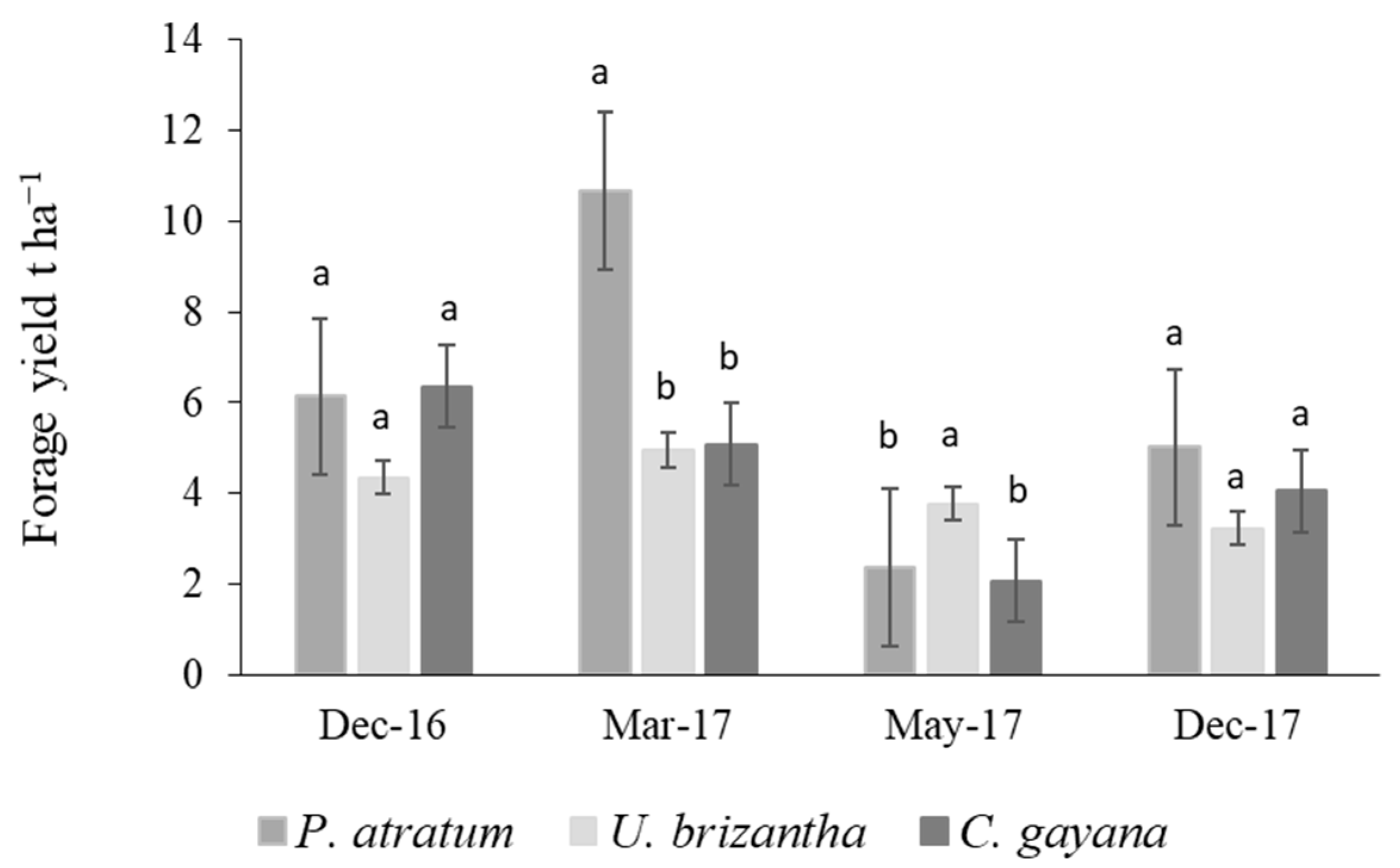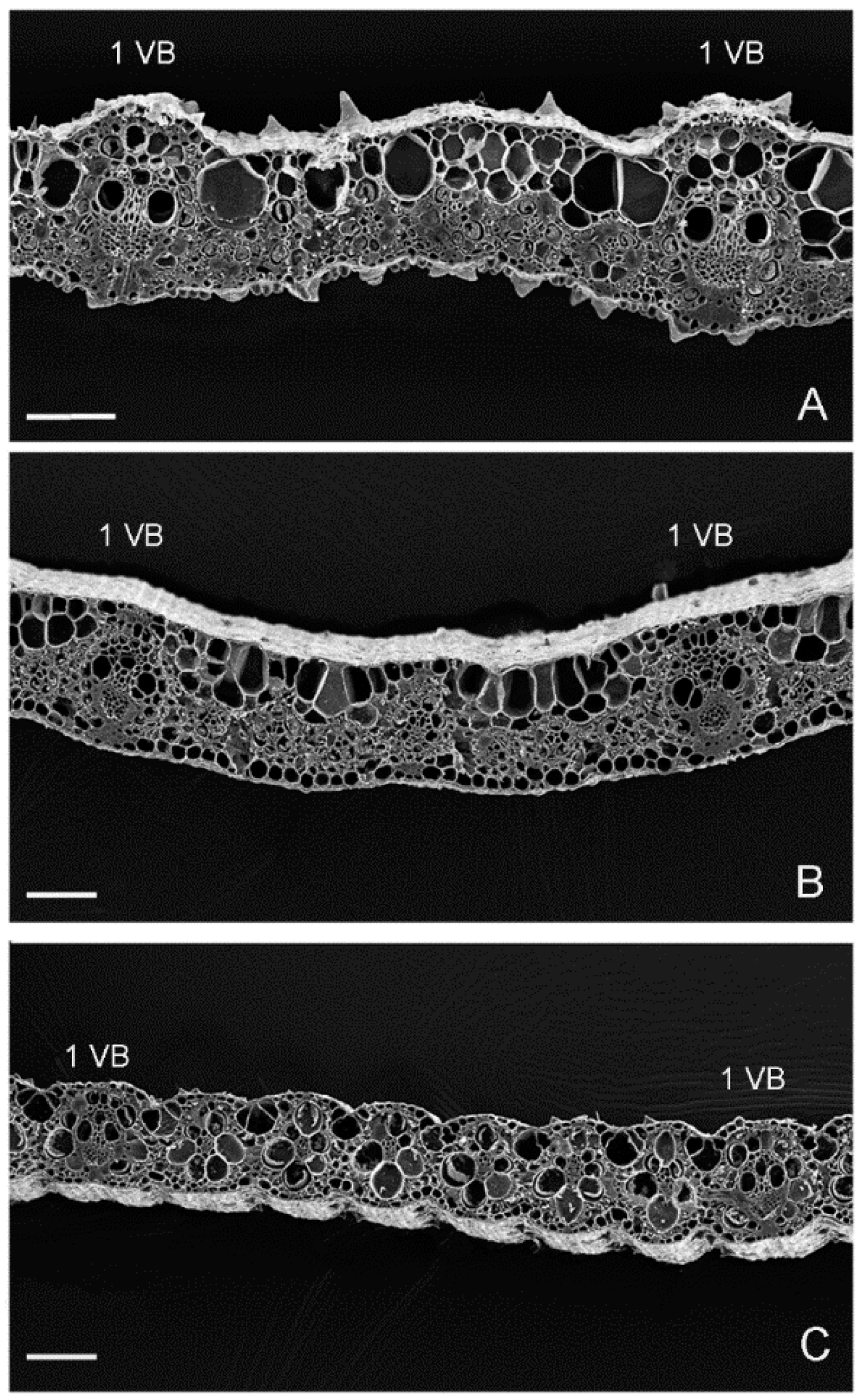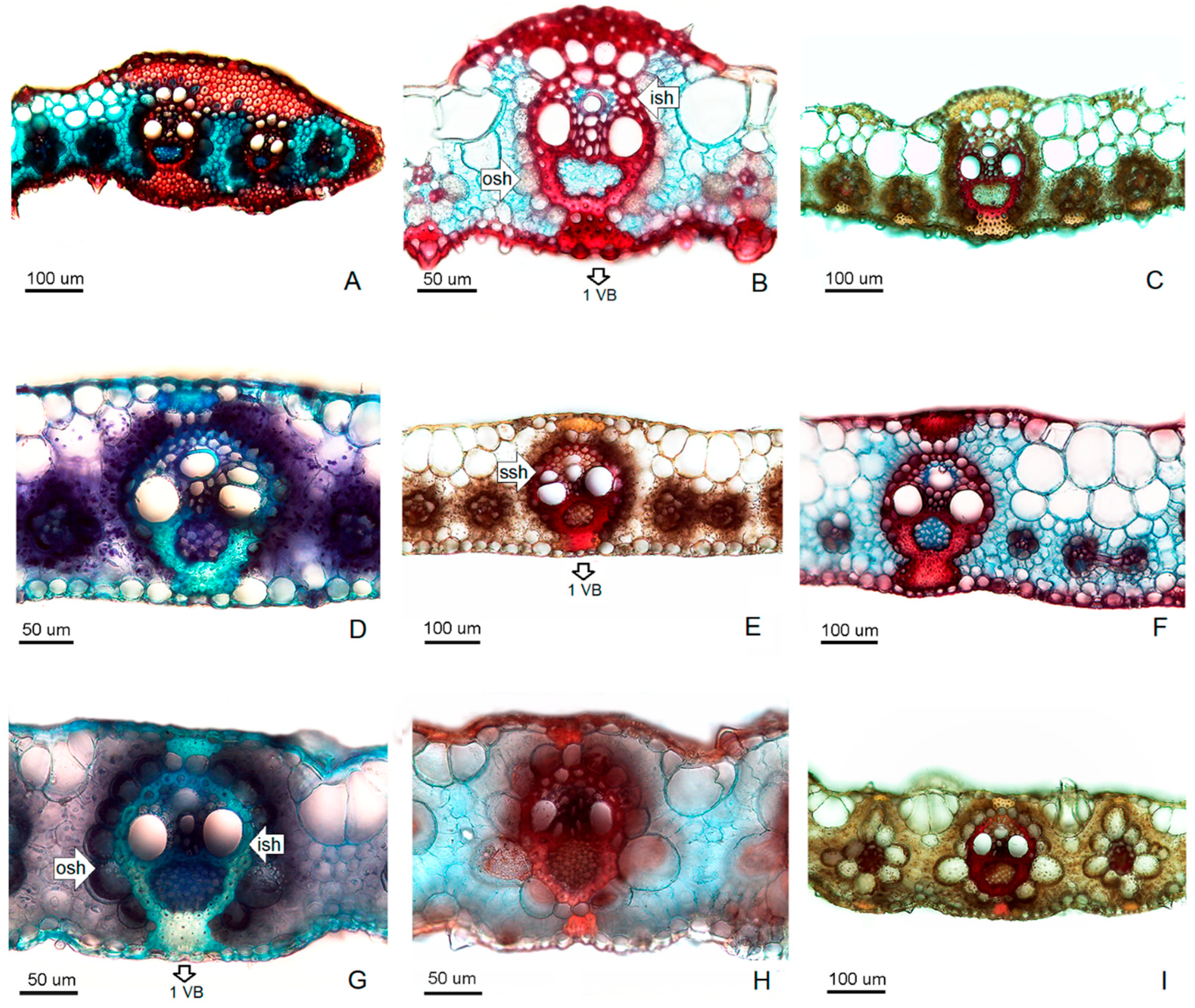Cattle Preference in Warm-Season Grasses: Effects of Seasonal Growth, Leaf Morphology, and Leaf Anatomy
Abstract
1. Introduction
2. Materials and Methods
2.1. Plant Material and Experimental Site
2.2. Forage Yield and Cattle Preference
2.3. Morphological and Leaf Anatomy Evaluations
2.4. Statistical Analysis
3. Results
3.1. Forage Yield and Cattle Preference
3.2. Morphological Evaluations
3.3. Proportion of Leaf Tissues
3.4. Proportion of Leaf Tissues
3.5. Principal Component Analysis and Pearson Correlation Test
4. Discussion
Author Contributions
Funding
Data Availability Statement
Conflicts of Interest
References
- Rutter, S.M. Review: Grazing preferences in sheep and cattle: Implications for production, the environment and animal welfare. Can. J. Anim. Sci. 2010, 90, 285–445. [Google Scholar] [CrossRef]
- Martens, D.R.; Grant, R.J. Digestibility and intake. In Forages: The Science of Grassland Agriculture, 7th ed.; Moore, K.J.M., Collins, C.J., Redfearn, D.D., Eds.; Wiley: Hoboken, NJ, USA, 2020; Volume 2, pp. 609–631. [Google Scholar]
- Cuchillo-Hilario, M.; Wrage-Monnig, N.; Isselstein, J. Forage selectivity by cattle and sheep co-grazing swards differing in plant species diversity. Grass Forage Sci. 2018, 73, 320–329. [Google Scholar] [CrossRef]
- Allison, C.D. Factors affecting forage intake by range ruminants: A review. J. Range Manag. 1985, 38, 305–311. [Google Scholar] [CrossRef]
- Beaumont, A.B.; Stitt, R.E.; Snell, R.S. Some factors affecting the palatability of pasture plants. J. Am. Soc. Agron. 1933, 25, 123–128. [Google Scholar] [CrossRef]
- Rutter, S.M. Diet preference for grass and legumes in free-ranging domestic sheep and cattle: Current theory and future application. Appl. Anim. Behav. Sci. 2006, 97, 17–35. [Google Scholar] [CrossRef]
- Caram, N.; Casalás, F.; Soca, P.; Wallau, M.O.; Sollenberger, L.E.; Cadenazzi, M.; Boggiano, P. Grazing intensity controls the seasonal utilization of functionally diverse patches by mediating herbivore selectivity. Rangel. Ecol. Manag. 2024, 96, 152–162. [Google Scholar] [CrossRef]
- Oliveira, B.A.; López, I.F.; Cranston, L.M.; Poli, C.H.E.C.; Kemp, P.D.; Donaghy, D.J.; Draganova, I.; López-Villalobos, N. Animal behaviour and dietary preference of dairy cows grazing binary and diverse pastures under the leaf regrowth stage defoliation criterion. Anim. Feed Sci. Technol. 2024, 318, 116146. [Google Scholar] [CrossRef]
- Sollenberger, L.E.; Vendramini, J.M.B.; Pedreira, C.G.S.; Rios, E.F. Warm-season grasses for humid areas. In Forages: The Science of Grassland Agriculture, 7th ed.; Moore, K.J.M., Collins, C.J., Redfearn, D.D., Eds.; Wiley: Hoboken, NJ, USA, 2020; Volume 2, pp. 331–346. [Google Scholar]
- Coleman, S.W.; Moore, J.E.; Wilson, J.R. Quality and utilization. In Warm-Season (C4) Grasses; Moser, L.E., Burson, B.L., Sollenberger, L.E., Eds.; ASA, CSSA, SSSA: Madison, WI, USA, 2004; Volume 45, pp. 267–308. [Google Scholar]
- Otaviano, E.K.S.; Mammana, A.F.; Gomes, C.M.; Silva, A.M.S.; Carvalho, L.F.G.; Sbrissia, A.F.; Barbosa, R.M.; Sollenberger, L.E.; Silva, S.C. Canopy structure and herbage intake rate of three tropical forage grasses cultivated as pure or mixed stands. Crop Pasture Sci. 2024, 75, CP24125. [Google Scholar] [CrossRef]
- Forbes, T.D.A.; Coleman, S.W. Forage intake and ingestive behavior of cattle grazing old world bluestems. Agron. J. 1993, 85, 808–816. [Google Scholar] [CrossRef]
- Benvenutti, M.A.; Gordon, I.J.; Poppi, D.P. The effects of stem density of tropical swards and age of grazing cattle on their foraging behavior. Grass Forage Sci. 2008, 63, 1–8. [Google Scholar] [CrossRef]
- MacAdam, J.W.; Mayland, H.F. The relationship of leaf strength to cattle preference in tall fescue cultivars. Agro. J. 2003, 95, 414–419. [Google Scholar] [CrossRef]
- Marcón, F.; Di Lorenzo, E.L.; Peichoto, M.C.; Acuña, C.A. Cattle preference in Paspalum atratum and its relationship with morphological and anatomical leaf characteristics. Crop Sci. 2023, 63, 1659–1673. [Google Scholar] [CrossRef]
- Akin, D.E.; Burdick, D. Percentage of tissue types in tropical and temperate grass leaf blades and degradation of tissues by rumen microorganisms. Crop Sci. 1975, 15, 661–668. [Google Scholar] [CrossRef]
- Moser, L.E.; Burson, B.L.; Sollenberger, L.E. Warm season (C4) grass overview. In Warm-Season (C4) Grasses; Moser, L.E., Burson, B.L., Sollenberger, L.E., Eds.; ASA, CSSA, SSSA: Madison, WI, USA, 2004; Volume 45, pp. 1–14. [Google Scholar]
- Marchi, S.R.; Bellé, J.R.; Foz, C.H.; Ferri, J.; Martins, D. Weeds alter the establishment of Brachiaria brizantha cv. Marandu. Trop. Grassl.-Forrajes Trop. 2017, 5, 85–93. [Google Scholar] [CrossRef]
- Loch, D.S.; Rethman, N.F.G.; Van Niekerk, W.A. Rhodesgrass. In Warm-Season (C4) Grasses; Moser, L.E., Burson, B.L., Sollenberger, L.E., Eds.; ASA, CSSA, SSSA: Madison, WI, USA, 2004; Volume 45, pp. 833–872. [Google Scholar]
- Chiachiera, S.; Bertram, N.; Taleisnik, E.; Jobbágy, E. Effect of watertable depth and salinity on growth dynamics of Rhodes grass (Chloris gayana). Crop Pasture Sci. 2016, 67, 881–887. [Google Scholar] [CrossRef]
- Kalmbacher, R.S.; Brown, W.F.; Colvin, D.L.; Dunavin, L.S.; Kretschmer, A.E.; Martin, F.G.; Mullahey, J.J.; Rechcigl, J.E. Suerte Atra Paspalum: Its management and utilization. In Circular S-397; Florida Cooperative Extension Service, Institute of Food and Agricultural Sciences, University of Florida: Gainesville, FL, USA, 1997. [Google Scholar]
- Marcón, F.; Urbani, M.H.; Quarin, C.L.; Acuña, C.A. Agronomic characterization of Paspalum atratum Swallen and P. lenticulare Kunth. Trop. Grassl.-Forrajes Trop. 2018, 6, 70–81. [Google Scholar] [CrossRef]
- Ledesma, L.L. Los Suelos de la Estación Experimental Agropecuaria Colonia Benítez “Dr. Augusto G. Schulz” Provincia del Chaco; Instituto Nacional de Tecnología Agropecuaria (INTA): Buenos Aires, Argentina, 1995; pp. 1–38. [Google Scholar]
- Zarlavsky, G.E. Histología vegetal técnicas simples y complejas. Soc. Argent. Bot. 2014, 1–198. [Google Scholar]
- Luque, R.; Sousa, H.C.; Kraus, J.E. Métodos de coloração de Roeser (1972)–modificado- e Kropp (1972) visando a substituição do azul de astra de alcião 8 GS ou 8 GX. Acta Bot. Bras. 1996, 10, 199–212. [Google Scholar] [CrossRef]
- Ruzin, S.E. Plant Microtechnique and Microscopy; Oxford University Press: New York, NY, USA, 1999; Volume 198, p. 322. [Google Scholar]
- Schneider, C.A.; Rasband, W.S.; Eliceiri, K.W. NIH Image to ImageJ: 25 years of image analysis. Nat. Methods 2012, 9, 671–675. [Google Scholar] [CrossRef] [PubMed]
- Gonzalez, A.M. Image J: Una herramienta indispensable para medir el mundo biológico. Folium Relatos Botánicos 2018, 1, 6–17. [Google Scholar]
- Di Rienzo, J.A.; Casanoves, F.; Balzarini, M.G.; Gonzalez, L.; Tablada, M.; Robledo, C.W. InfoStat. Grupo InfoStat. FCA, Universidad Nacional de Córdoba. 2020. Available online: http://www.infostat.com.ar (accessed on 15 September 2025).
- Batistoti, C.; Lempp, B.; Jank, L.; Morai, M.D.G.; Cubas, A.C.; Gomes, R.A.; Ferreira, M.V.B. Correlations among anatomical, morphological, chemical and agronomic characteristics of leaf blades in Panicum maximum genotypes. Anim. Feed Sci. Technol. 2012, 171, 173–180. [Google Scholar] [CrossRef]
- Wilson, J.R.; Anderson, K.L.; Hacker, J.B. Dry matter digestibility in vitro of leaf and stem of Buffel Grass (Cenchrus ciliaris) and related species and its relation to plant morphology and anatomy. Aust. J. Agric. Res. 1989, 40, 281–291. [Google Scholar] [CrossRef]
- Wilson, J.R. Organization of forage plant tissue. In Forage Cell Wall Structure and Digestibility; Jung, H.G., Buxton, D.R., Hatifield, R.D., Ralph, J., Eds.; ASA, CSSA, SSSA: Madison, WI, USA, 1993; pp. 1–27. [Google Scholar]
- Zhang, J.M.; Hongo, A.; Akimoto, M. Physical strength and its relation to leaf anatomical characteristics of nine forage grasses. Aust. J. Bot. 2004, 52, 799–804. [Google Scholar] [CrossRef]
- Basso, K.C.; Galzerano, L.; Da Silva, W.L.; Ruggieri, A.C.; Reis, R.A. Anatomical, morphogenic and structural characteristics of Xaraés palisade grass under grazing. Biosci. J. 2023, 39, e39067. [Google Scholar] [CrossRef]
- Alves de Brito, C.J.F.; Rodella, R.A.; Deschamps, F.C. Anatomia quantitativa da folha e do colmo de Brachiaria brizantha (Hochst. ex A. Rich.) Stapf e B. humidicola (Rendle) Schweick. R. Bras. Zootec. 2004, 33, 519–528. [Google Scholar] [CrossRef]





| Dec-16 | Mar-17 | May-17 | Dec-17 | |||||||||
|---|---|---|---|---|---|---|---|---|---|---|---|---|
| PH | LBL | LBW | PH | LBL | LBW | PH | LBL | LBW | PH | LBL | LBW | |
| cm | mm | cm | mm | cm | mm | cm | mm | |||||
| PA | 97.92 | 66.32 | 16.92 | 146.75 | 76.06 | 23.25 | 60.92 | 44.92 | 15.00 | 75.65 | 48.83 | 13.67 |
| UB | 68.75 | 33.43 | 16.06 | 91.69 | 36.19 | 18.13 | 58.88 | 37.44 | 12.75 | 47.38 | 30.19 | 15.25 |
| CG | 85.06 | 41.1 | 4.69 | 114.06 | 54.5 | 6.81 | 66.44 | 43.38 | 6.25 | 69.25 | 41.97 | 5.5 |
| CV | 9.37 | 13.78 | 8.36 | 9.92 | 7.35 | 10.19 | 6.25 | 7.18 | 6.82 | 5.33 | 3.82 | 6.01 |
| MSD | 13.31 | 10.70 | 1.74 | 19.58 | 6.78 | 2.69 | 6.67 | 5.13 | 1.28 | 5.77 | 2.59 | 1.16 |
| Epidermis (%) | ||||||||||||
| December 2016 | March 2017 | May 2017 | December 2017 | |||||||||
| Mid. | Int. | Mar. | Mid. | Int. | Mar. | Mid. | Int. | Mar. | Mid. | Int. | Mar. | |
| PA | 4.87 | 12.66 | 34.1 | 4.42 | 15.38 | 31.7 | 5.65 | 13.7 | 31.42 | 4.23 | 17.75 | 30.21 |
| UB | 8.82 | 11.8 | 17.9 | 9.07 | 12.77 | 16.93 | 9.07 | 12.8 | 16.9 | 11.55 | 11.31 | 16.34 |
| CG | 5.37 | 10.28 | 17.3 | 3.83 | 9.16 | 14.85 | 6.46 | 10.2 | 15.2 | 6.5 | 11.1 | 14.1 |
| CV | 10.41 | 7.77 | 6.88 | 9.98 | 15.2 | 18.1 | 9.23 | 19.5 | 7.38 | 14.12 | 8.78 | 4.66 |
| MSD | 1.05 | 1.10 | 1.95 | 0.89 | 2.65 | 5.27 | 1.05 | 3.24 | 2.16 | 2.04 | 2.47 | 2.01 |
| Bulliform Cells (%) | ||||||||||||
| December 2016 | March 2017 | May 2017 | December 2017 | |||||||||
| Mid. | Int. | Mar. | Mid. | Int. | Mar. | Mid. | Int. | Mar. | Mid. | Int. | Mar. | |
| PA | 1.7 | 17.11 | 0 | 0.83 | 16.04 | 5.26 | 2.37 | 15.12 | 0.81 | 1.32 | 12.58 | 3.86 |
| UB | 6.2 | 15.31 | 8.49 | 2.8 | 10.28 | 4.37 | 3.44 | 12.2 | 7.5 | 8.56 | 6.97 | 7.42 |
| CG | 4.57 | 21.92 | 1.42 | 2.19 | 21.34 | 2.44 | 3.95 | 16.8 | 1.12 | 3.41 | 21.3 | 7.01 |
| CV | 44.27 | 10.06 | 39.39 | 26.4 | 27.7 | 66.1 | 34.6 | 18.7 | 50.6 | 46.05 | 32.89 | 37.08 |
| MSD | 2.94 | 2.42 | 1.60 | 0.76 | 5.75 | 4.54 | 1.78 | 3.81 | 2.41 | 3.16 | 8.45 | 3.95 |
| Parenchyma (%) | ||||||||||||
| December 2016 | March 2017 | May 2017 | December 2017 | |||||||||
| Mid. | Int. | Mar. | Mid. | Int. | Mar. | Mid. | Int. | Mar. | Mid. | Int. | Mar. | |
| PA | 80.34 | 45.86 | 43.01 | 82.83 | 42.89 | 41.17 | 80.27 | 46.59 | 43.42 | 79.41 | 41.95 | 40.87 |
| UB | 39.57 | 30.66 | 29.43 | 45.52 | 31.79 | 31.44 | 57.3 | 31.7 | 30.1 | 30.12 | 39.46 | 35.19 |
| CG | 71.71 | 33.37 | 21.34 | 77.31 | 26.04 | 29.5 | 69.8 | 28.1 | 25.1 | 67.5 | 24.9 | 26.5 |
| CV | 13.00 | 3.61 | 14.47 | 2.09 | 9.36 | 7.93 | 3.14 | 6.84 | 9.44 | 2.55 | 14.8 | 10.35 |
| MSD | 5.86 | 1.38 | 2.73 | 2.18 | 4.47 | 3.8 | 3.78 | 3.39 | 4.39 | 3.04 | 10.6 | 7.1 |
| Bundle Sheath (%) | ||||||||||||
| December 2016 | March 2017 | May 2017 | December 2017 | |||||||||
| Mid. | Int. | Mar. | Mid. | Int. | Mar. | Mid. | Int. | Mar. | Mid. | Int. | Mar. | |
| PA | 4.08 | 10.09 | 9.95 | 3.46 | 10.5 | 9.08 | 4.87 | 11.77 | 12.02 | 4.44 | 4.44 | 10.56 |
| UB | 23.75 | 25.18 | 14.6 | 23.36 | 27.93 | 14.55 | 17.4 | 29.9 | 19.1 | 30.36 | 31.35 | 23.69 |
| CG | 7.57 | 17.84 | 20.58 | 5.53 | 18.8 | 16.27 | 9.6 | 21.7 | 20 | 11.7 | 22.5 | 19.7 |
| CV | 8.11 | 9.10 | 17.57 | 8.72 | 7.54 | 11.7 | 10.5 | 6.23 | 10.7 | 11.2 | 10.76 | 9.46 |
| MSD | 1.76 | 1.68 | 3.39 | 1.46 | 1.83 | 2.05 | 1.71 | 1.67 | 2.4 | 2.69 | 3.47 | 2.85 |
| Lignified Tissues (%) | ||||||||||||
| December 2016 | March 2017 | May 2017 | December 2017 | |||||||||
| Mid. | Int. | Mar. | Mid. | Int. | Mar. | Mid. | Int. | Mar. | Mid. | Int. | Mar. | |
| PA | 7.6 | 11.94 | 11.29 | 7.32 | 13.18 | 10.67 | 5.76 | 10.75 | 10.53 | 8.97 | 12.53 | 12.33 |
| UB | 19.28 | 14.81 | 27.87 | 16.34 | 13.94 | 31 | 13.2 | 11.7 | 24.1 | 16.84 | 9 | 15.76 |
| CG | 9.4 | 14.06 | 36.8 | 9.15 | 20.76 | 33.99 | 8.71 | 19.9 | 35.8 | 9.59 | 17 | 30.3 |
| CV | 17.57 | 34.85 | 6.58 | 6.38 | 12.3 | 7.16 | 8.08 | 8.76 | 16.2 | 14.09 | 8.73 | 17.76 |
| MSD | 3.39 | 5.83 | 2.05 | 1.04 | 2.61 | 2.27 | 1.19 | 1.69 | 4.86 | 2.85 | 1.93 | 5.68 |
| Number of Primary Vascular Bundle | Distance Primary VB (µm) | |||||||||||
|---|---|---|---|---|---|---|---|---|---|---|---|---|
| Dec16 | Mar17 | May17 | Dec17 | Dec16 | Mar17 | May17 | Dec17 | |||||
| Int. | Mid. | Int. | Mid. | Int. | Mid. | Int. | Mid. | |||||
| PA | 9.17 | 3.8 | 9.83 | 5 | 8.33 | 3 | 7.67 | 5.33 | 1227.5 | 1013 | 950.56 | 585.27 |
| UB | 5 | 1 | 6 | 1 | 6 | 1 | 4.67 | 1 | 1459.4 | 1444.3 | 1392 | 1096.8 |
| CG | 3 | 1 | 3 | 3 | 4 | 1 | 4 | 3 | 692.5 | 921.4 | 842 | 675 |
| CV | 11.80 | 32.71 | 4.73 | 0 | 13.6 | 51.5 | 8.03 | 9.36 | 12.10 | 19.1 | 17.1 | 15.2 |
| MSD | 0.83 | 0.88 | 0.4 | 0.4 | 1.14 | 1.49 | 0.76 | 0.54 | 167.72 | 289.9 | 245 | 243.39 |
| Traits | Pearson Correlation Coefficient | p-Value |
|---|---|---|
| FY | −0.67 | <0.001 |
| N°VB.Mid | −0.63 | <0.001 |
| PH | −0.61 | <0.001 |
| LBL | −0.56 | <0.001 |
| N°VB.Int | −0.52 | 0.358 |
| Epid.Mar | −0.42 | 0.010 |
| LBW | −0.37 | 0.024 |
| Par.Mar | −0.34 | 0.041 |
| Epid.Int | −0.28 | 0.097 |
| Par.Mid | −0.25 | 0.134 |
| Par.Int | −0.21 | 0.212 |
| LT.Int | −0.11 | 0.517 |
| Bull.Int | −0.09 | 0.614 |
| Bull.Mar | −0.05 | 0.791 |
| LT.Mid | −0.01 | 0.943 |
| Dist.VB | 0.02 | 0.928 |
| LT.Mar | 0.28 | 0.100 |
| BS.Mid | 0.29 | 0.082 |
| Bull.Mid | 0.32 | 0.053 |
| Epid.Mid | 0.43 | 0.008 |
| BS.Int | 0.53 | <0.001 |
| BS.Mar | 0.61 | <0.001 |
Disclaimer/Publisher’s Note: The statements, opinions and data contained in all publications are solely those of the individual author(s) and contributor(s) and not of MDPI and/or the editor(s). MDPI and/or the editor(s) disclaim responsibility for any injury to people or property resulting from any ideas, methods, instructions or products referred to in the content. |
© 2025 by the authors. Licensee MDPI, Basel, Switzerland. This article is an open access article distributed under the terms and conditions of the Creative Commons Attribution (CC BY) license (https://creativecommons.org/licenses/by/4.0/).
Share and Cite
Marcón, F.; Di Lorenzo, E.L.; Peichoto, M.C.; Acuña, C.A. Cattle Preference in Warm-Season Grasses: Effects of Seasonal Growth, Leaf Morphology, and Leaf Anatomy. Grasses 2025, 4, 40. https://doi.org/10.3390/grasses4040040
Marcón F, Di Lorenzo EL, Peichoto MC, Acuña CA. Cattle Preference in Warm-Season Grasses: Effects of Seasonal Growth, Leaf Morphology, and Leaf Anatomy. Grasses. 2025; 4(4):40. https://doi.org/10.3390/grasses4040040
Chicago/Turabian StyleMarcón, Florencia, Elio L. Di Lorenzo, Myriam C. Peichoto, and Carlos A. Acuña. 2025. "Cattle Preference in Warm-Season Grasses: Effects of Seasonal Growth, Leaf Morphology, and Leaf Anatomy" Grasses 4, no. 4: 40. https://doi.org/10.3390/grasses4040040
APA StyleMarcón, F., Di Lorenzo, E. L., Peichoto, M. C., & Acuña, C. A. (2025). Cattle Preference in Warm-Season Grasses: Effects of Seasonal Growth, Leaf Morphology, and Leaf Anatomy. Grasses, 4(4), 40. https://doi.org/10.3390/grasses4040040







